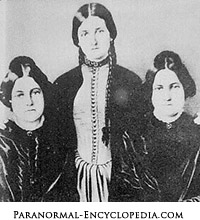Spiritualism
Spiritualism Beliefs & Philosophy
The three main tenets of Spiritualism are:
- the survival of the spirit after death,
- the ongoing concern of the deceased (spirits) for the living,
- the ability of those spirits to communicate with the living through a medium (a person who serves as an intermediary between the spirits and the living).
Spiritualism is founded on a set of nine principles, the "Declaration of Principles," which followers believe were received from the Spirit World. Although not a creed, the Declaration of Principles is the consensus of the majority of Spiritualists7.
Spiritualist Contact
The most common form of communication traditionally used to contact the spirit world was the séance, a ritualistic meeting usually led by a medium with participants sitting in a circle holding hands. However, Spiritualistic phenomena today can express themselves through various means including prophecy, clairvoyance, clairaudience, speaking in tongues, healing, laying on of hands, visions, trances, revelations, raps, levitation, automatic and independent writing or painting, photography, materialization, psychometry, direct and independent voice, and any other manifestation that proves the continuity of life 2, 4, 5 ,7.
Spiritual Healing
Spiritual healing has been a principle of Spiritualism since its establishment as a religion. However, it differs from faith healing in that the patient need have no faith in the treatment. Faith healers also claim instant cures, while in Spiritual healing the cures are rarely instantaneous. Additionally, rather than belief in divine intervention, the Spiritual healer believes that spirits work through him or her to energize and heal the patient7.
Spiritualism History
Spiritualism is both a religious philosophy and a science that deals with the origin, method, and validity of knowledge2.

Left to right: Margaret, Kate, Leah
The modern Spiritualism movement began in March of 1848 when young sisters Catherine and Margaretta Fox claimed that a dead peddler was communicating with them through rapping on a table in their new home in Hydesville, New York. Soon after, both sisters went to live with their older sibling, Leah, who also claimed to have mediumistic abilities3.
A newspaper account of the sisters' experiences popularized "Spiritualism"3, 4 and made it a major social movement and in 1949, a small group of Spiritualists met at Corinthian Hall in Rochester, New York.
Marcellus Ayer established The First Spiritual Temple in 1885.
Emanuel Swedenborg (1688-1772), Franz Mesmer (1734-1815), and Andrew Jackson Davis (1826-1910) were all significant influences in the advancement of Spiritualism. Swedenborg and Davis were both self-proclaimed clairvoyants who reported frequent contact with the dead. Although Mesmer didn't directly contribute to the new religion, his technique of mesmerism (later called hypnotism) induced trances, during which participants claimed to be in contact with the dead. In fact, Davis claimed to have foreseen the coming of the Spiritualist movement while in a hypnotic trance4, 6.
The Fox sisters caught the attention of showman P.T. Barnum who took them to New York City and introduced them in a stage act that made them national celebrities. In the years following, mediumistic talents continued to gain popularity with the public and demonstrations, such as séances and automatic writing, proved quite profitable.
Soon, outcries of fraud by many prominent people and criticism by the medical community brought the Spiritualism movement into discredit. Professional researchers such as Frank Podmore of the Society for Psychical Research worked diligently to expose frauds 3, 4.
Finally, a near final blow came to Spiritualism when, in 1888, the Fox sisters admitted that since the beginning, the "rappings" were really just the cracking of their own toe joints2, 4.
Still, a number of prominent people, such as Sir Arthur Conan Doyle, remained devout believers in Spiritualism and the religion has not only survived, but has grown in numbers. Spiritualism is a recognized religion in the United States. In the 1990s, 600 U.S. congregations reported a combined membership of over 210,000 individuals.
1. “spiritualism .” World Encyclopedia. Oxford University Press, 2006. 1 Sep 2008 <http://www.highbeam.com/doc/1O142-spiritualism.html>.
2. Joan Townsend. “Spiritualism .” Canadian Encyclopedia. 2002. 1 Sep 2008 <http://www.highbeam.com/doc/1P1-70917687.html>.
3. “Spiritualism .” Wikipedia, the free encyclopedia. Wikimedia Foundation, Inc., 2008. 1 Sep 2008 <http://en.wikipedia.org/wiki/Spiritualism>.
4. James K. Crissman. “Spiritualism Movement.” Macmillan Encyclopedia of Death and Dying. Farmington Hills, Michigan: The Gale Group, 2002. 1 Sep 2008 <http://www.highbeam.com/doc/1G2-3407200266.html>.
5. “spiritism.” The Columbia Encyclopedia. Columbia University Press, 2008. 1 Sep 2008 <http://www.highbeam.com/doc/1E1-spiritis.html>.
6. Robert Todd Carroll. “spiritualism (spiritism).” The Skeptics Dictionary. 2007. 1 Sep 2008 <http://www.skepdic.com/spiritul.html>.
7. “National Spiritualist Association of Churches.” National Spiritualist Association of Churches 2008. 1 Sep 2008 <http://www.nsac.org/>.
Further study:
